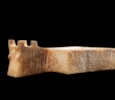Libation Table
Libation Table
Yemen
7th - 5th Century B.C.
Alabaster
H: 11.5 x W: 27.5 x D: 36.5 cm
Sold
Translation Sâdiq son of ‘Ammî’ anas, son of Hayw, son of Ya[r]ta, dedicated Milhuhumû, his children and his possessions to ‘Athtar, for Almaqah, for dhât-Himyam and for Samî. Transcription DQM BN ‘M’NS BN h. ywm bn y[]t’ hqny ‘ttr wsm’ d-z. byt mlh. hmw wwldhw[]wqnyhw b’ttr wb ‘lmqh wb d-th. mym wb sm’ This rectangular libation table, carved out of a thick piece of alabaster, is engraved all around the edges with a Sabean inscription. The dedication is made to the god ‘Sami dhu-- Zabyat’, and allows us to determine the provenance of this table most likely to Jidfir Ibn Munaykhir, ancient Kuha-l, in modern day Yemen. The table has a raised border and a smooth flat interior, slightly slanted to guide libations to the overflow shaped like a stylized bull’s head. A shallow groove between the horns serves as a drain. The prominent eyes rest under vertical ears and horns. The abstract style of the bull’s head is softened by the curve of the drain on the forehead, elegantly flaring when joining the horns, and the white cream colour of the alabaster. The bull occupied an important role in South Arabian sacrificial rituals and its image can be found on sacrificial tables, funeral stelae, statues temple friezes and more. The bull is associated with the gods Sami and Wadd in the Yemeni Jawf, with Sayyin in the Hadramite culture, and with Anbay in Qataba-n. It is a symbol of fertility and reproduction, as well as rebirth after death. Given this dual function, the image of the bull appears both in temples and in funerary contexts throughout the 1st millennium BC and in the following centuries. Libation tables were used to honour the dead and the gods. They concretized offerings of food, drink and blood: a channel allowed water or blood to flow on to the floor, thus recreating the sacrificial offerings being made. Some libation tables were engraved with offering scenes or rituals, although in this stunning example a dedication was carved on its edges. Only the nose of the bull is exempt from engravings. The text starts on the front side, on the left of the bucranium, then continues clockwise. On the first four sides, the text was carved on a single line, then the letters diminished in size to allow two lines on top of each other. The mention of three generations in one dedication is particularly rare, making this libation table one of the finest examples of its kind. It is important to note that this is perhaps one of the most widely published and exhibited South Arabian artworks in private hands, and that it was selected to be included in many museum publications and exhibitions for its extraordinary quality, rarity and provenance.
Yémen, au pays de la reine de Saba, Institut du Monde Arabe, Paris, 25th October 1997 – 28th February 1998.
Kunst und Archäologie im Land der Königin von Saba, Kunsthistorisches Museum, Vienna, 9th November 1998 – 21st February 1999.
Yemen Nel paese della regina di Saba, Palazzo Ruspoli, Fondazione Memmo, Rome, 6th April 2000 – 30th June 2000.
'La Regina di Saba, Arte e Leggenda Dallo Yemen' Palazzo Bricherasio, Turin, 26th September 2000 – 30th June 2001.
Museo del Instituto Biblico y Oriental, León, Spain, 2009-2020.
Antiquities and Primitive Art, Christie’s, London, 25 February 1975, Lot 178.
Jacques Ryckmans, On Both Sides of Al-Mandab, Un table à Libations avec inscription sabeenne
provenant du Gawf du Yemen, Swedish Research Institute in Istanbul, 13 May 1989, pp. 69–81
Les Metamorphoses Divines d’Alexandre, 1996, p158 & p369-370.
Yemen au pays de la reine de Saba, Institut du Monde Arabe 1997, p80.
Jemen, Kunst und Archäologie im Land der Königin von Saba, Kunsthistorisches Museum, Vienna, 1998, No. 45.
Yemen Nel paese della regina di Saba, Palazzo Ruspoli, Fondazione Memmo, Rome, 2000, No. 43, p122 & p286.
Alexandre le Grand sur la route legendaire des royaumes de Saba, , 2000, p23.
'La Regina di Saba, Arte e Leggenda Dallo Yemen' Palazzo Bricherasio, Turin, 2000, p46.
Treasures from Ancient Yemen: On the Legendary Road of the Kingdom of Sheba, c.2009, No. 12.
David Aaron, 2021, No.4.
Most likely from Jawf, Yemen
Previously in the Private Collection of Mr G.R., UK, prior to 1975, most likely prior to 1970.
Sold at: Antiquities and Primitive Art, Christie’s, London, 25 February 1975, Lot 178.
In the Collection of the well-known Swedish orientalist Oscar Anders Valfrid Löfgren (1898-1992) who was given this libation altar on his ninetieth birthday on 13th May 1988 by his friends and colleagues for his substantial contribution to South Arabian and Ethiopian philology.
Private Collection of F.A. (b.1934), France since at least 1996 (accompanied by French Cultural Passport 045496 & Spanish export license).
ALR: S00201737, with IADAA Certificate, this item has been checked against the Interpol database.
Oscar Anders Valfrid Löfgren (1898–1992) was a Swedish orientalist. He studied classical philology and Semitic philology, obtaining a degree in 1927. Over the next 25 years Löfgren taught at various institutes and universities, but without finding a permanent job anywhere. Only in 1951 was he appointed Professor of Semitic Languages at the University of Gothenburg (where he had studied 60 years earlier), and in 1956 he moved to the University of Uppsala.
His achievements mainly include translated editions of Amharic and South Arabian texts, such as the 1930 edition of the Ethiopian version of Die Athiopische Dodekapropheton. An expert codicologist, he published various catalogues of Arabic and Ethiopian manuscripts. With Renato Traini , he published the first 4 volumes of the catalogue of Arab manuscripts of the Ambrosian Library in Milan. In 1987 he signed an agreement with the Antiques Division of the Brill Editore publishing house in Leiden for the sale of his private library. Under the agreement, the library became Brill’s property at the time of his death in 1992.










 Enquire
Enquire




